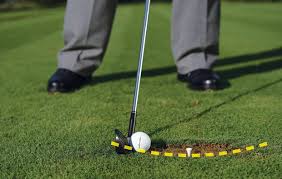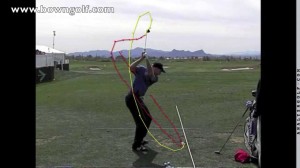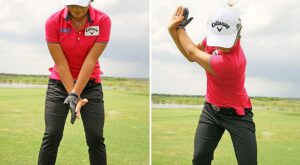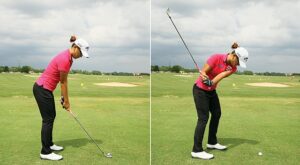It changes with each club. Knowing where each club should reach the bottom of the swing arc is critical for consistently great shots. A recent blog from Golf-Info-Guide by Thomas Golf about hitting fairway woods “off the deck” reminded me that the bottom of the swing arc is different for each type of club.
First you need to accept that fact that there are 2 types of swings which change the location of the bottom of your swing: Full Swing and Putting/Chipping Swing.
The “Full Swing” includes a weight shift to your forward foot as you rotate your hips and shoulders through the swing. The bottom of your swing moves forward of the center of your stance. Use the Full Swing with your Driver, Fairway Woods, Hybrids and Irons.
The “Putting/Chipping Swing” is a pendulum swing WITHOUT the weight shift. If your shoulders are level, the bottom of your swing is exactly in the center of your stance. So for Putting your ball should be just forward of center for top roll and for chipping your ball should be centered or slightly back of center.
Now let’s look at the WHERE and WHY you want the bottom of your arc for each Full Swing club:
Driver: We want to connect with the ball on a 3 to 5 degree upswing (after you bottom out) and that is why we tee up for a driver and place the ball in-line with the insole of our leading foot.
Fairway Woods (3, 5 and Hybrid): The swing arc bottoms out at the point of impact for these clubs. This is referred to as hitting “off the deck” which should be forward of the center line of your stance (as your weight shifts forward). In low-cut fairway grass the 3 wood (with the longest shaft) is the most difficult shot to hit with a clean impact.
3 Iron through to Pitching Wedge: For all of these clubs the bottom of the swing arc should be just after the ball. In other words, you should be impacting with the ball and then taking a divot after the ball. Your club is actually hitting down through the ball to impart a reverse spin (instead of a top spin).
Knowing where you want to bottom your club should be at the top of your mind when you complete your practice swing. If you don’t bottom out at the right point, try again with the correct swing. It’s a great check for your swing. If you are not bottoming out on your swing you may be bending your leading arm. Wear your GOLFSTR+ when you practice and get it right: www.golfstr.com






